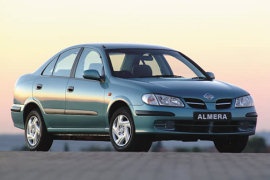
NISSAN Almera / Pulsar Sedan
Generations Timeline, Specs and Pictures

As most of the car-manufacturers did, Nissan introduced some vehicles for specific markets such it was the case with the 2011 Almera Sedan.
It was introduced for the South-East Asian market.
The Japanese car-maker was already in an alliance with Renault and the French engineers had good expertise in building cheap cars for rough roads, such as those from Thailand and the Philippines. Nissan, on the other hand, had a better reputation in that area and so, the 2011 Almera was introduced as an inexpensive family sedan.
With a design that wouldn’t win any beauty contest, the 2011 Almera Sedan followed the basic lines of the Versa and Tiida. The three-box sedan shape was built for a big interior room and trunk. It looked like it was built from inside out.
Inside, the Almera Sedan offered 5 seats and enough legroom and headroom for the rear passengers. It was fitted with an AC unit and vents for the rear passengers with dedicated control for a rear ventilator. The Bluetooth connection, steering wheel controls, and power-windows were on the standard features.
The only engine available was a 1.5-liter gasoline engine mated to a standard 5-speed manual, and an option for an automatic, while the top trim level came with a standard automatic tranny. The front McPherson suspension and trailing arms in the rear were built for harsher terrain, and with a bigger ground clearance than a regular sedan.

Nissan introduced the second generation of the Almera in 2000 in three body shapes, including a four-door sedan designed in Europe and its stablemates.
Unlike its predecessor, the Almera/Pulsar’s second generation was styled in Europe and followed European tastes, showing the Japanese carmaker’s commitment to getting a more significant market share on the Old Continent. It used a slightly modified Nissan platform and Renault technologies.
With a design still affected by the bio-design era, the Almera/Pulsar’s second-generation showed a few sharp angles that belonged to the new-edge-design rising trend. The corner-mounted turn signals featured clear lenses and yellow bulbs. It entered the competition in the compact segment, mainly against other Japanese carmakers. In the three-box sedan shape, it aimed at private customers and fleet companies as well.
Inside, the curved lines dominated the dashboard. Only the navigation screen (offered as an option) and the center vents featured squared lines. The speedometer took center stage in the instrument panel, flanked by the tachometer on the left and the fuel and coolant-temperature gauges on the right. The bucket seats were designed more for comfort and provided little bolstering. Its back seats featured a split-folding seatback and provided enough elbow and hip room but limited legroom for adult passengers. Its 393 liters (13.9 cu-ft) trunk was more than 25% smaller than the one offered by Ford Focus.
Under the hood, Nissan installed a choice of own or Renault-sourced turbo-diesel and gasoline engines. It paired them with a five-speed manual and an option for a four-speed automatic for the 1.8-liter version.

Not exactly a car that relies on looks to sell, the blandly styled Nissan Almera / Pulsar sedan had other features that made it such a great ride.
The 4-door version set itself from the hatches through an increased ground clearance and lack of a GTi package, available only with the 3-door variant. The model was launched with a choice of two gasoline engines, with displacements of 1392 cc and 1597 cc and a larger 2.0-liter Diesel plant. Cars were available with two trims, GX and SLX, the first having been the base-entry and the second a middle-class equipment level. The car is widely believed to posses one of the best chassis at the time.























































